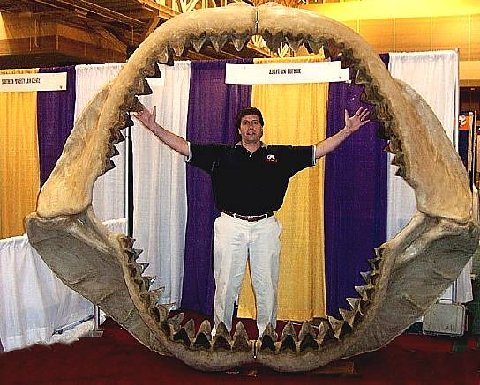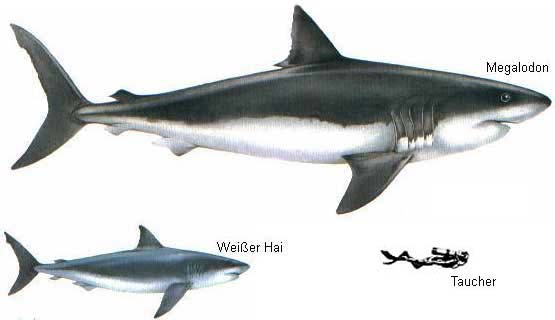Megalodon Slicing Up The Seals?
Posted by: Loren Coleman on August 18th, 2010

Okay, let’s throw out the obvious: Was it a 70-foot megalodon shark, Carcharodon or Carcharocles megalodon, long thought to be extinct, that is killing the seals?

Here is the latest from The Sun in the UK:
The mystery of mutilated seals
By TOM ROWLEY
Desperate boffins are trying to discover why dozens of mutilated seals are washing up on British beaches with their skin horrifically ripped off.
All the seals suffer the same wound — a single deep cut from head to stomach — but the top scientists can’t work out what’s behind the damage.
Horrific … the seals have had their skin sliced. [See photo here = Warning – image is graphic].
Science sleuths have been hunting for the ‘murder weapon’ since the first seals started dying last year, but they are still clueless. Now they are appealing to Sun readers to see if you can solve the mystery.
Horrified scientists have found around 60 carcasses so far. Most of the seals were spotted off the Norfolk coast, but ten more have been discovered at St Andrew’s on the east coast of Scotland.
Mechanical
The cut goes all the way around the seals’ bodies from head to stomach like a CORKSCREW.
Professors have so far eliminated sharks, tidal power generators and ordinary boat propellers from the list of suspects — but they have no idea what else could have caused the injuries.
The search is now on for a mystery vessel that could have inflicted the mechanical wounds.
Top mammal scientist Callan Duck told The Sun: “It’s a very clean cut – it looks like one single cut. If you’re cutting a loaf of bread, there’s a sawing action and you leave jagged edges, but there are none of those, so it looks like one continuous movement.
“The skin has been ripped clean off the seals’ jaws. It would take hours to do that with a scalpel yourself.”
The clever animals have learnt to avoid swimming too close to ships, leaving Mr Duck’s team puzzled that they seem to have swum into the blade HEAD FIRST.
He added: “Seals are pretty savvy creatures and they won’t approach an obvious threat, but very suddenly they’re being dragged head first into a rotating blade.”
The Scottish killings have already hit ten per cent of the breeding population of seals — and scientists are worried that the species could soon be wiped out entirely.
The seal team at St Andrew’s University has already asked the RSPCA, the National Trust and even the Scottish Government to solve the mystery — with no luck.
The baffled experts are now hoping Sun readers can piece together the puzzle for them.
Mr Duck said: “It’s a good mystery. We do believe it’s solvable. Once we find out where, we can move on to why and what.
“We’d like to encourage members of the public to call in and make suggestions.”
Experts are also keen for any snaps of the dead seals. Mr Duck added: “They can be smelly but please take a picture.”

About Loren Coleman
Loren Coleman is one of the world’s leading cryptozoologists, some say “the” leading living cryptozoologist. Certainly, he is acknowledged as the current living American researcher and writer who has most popularized cryptozoology in the late 20th and early 21st centuries.
Starting his fieldwork and investigations in 1960, after traveling and trekking extensively in pursuit of cryptozoological mysteries, Coleman began writing to share his experiences in 1969. An honorary member of Ivan T. Sanderson’s Society for the Investigation of the Unexplained in the 1970s, Coleman has been bestowed with similar honorary memberships of the North Idaho College Cryptozoology Club in 1983, and in subsequent years, that of the British Columbia Scientific Cryptozoology Club, CryptoSafari International, and other international organizations. He was also a Life Member and Benefactor of the International Society of Cryptozoology (now-defunct).
Loren Coleman’s daily blog, as a member of the Cryptomundo Team, served as an ongoing avenue of communication for the ever-growing body of cryptozoo news from 2005 through 2013. He returned as an infrequent contributor beginning Halloween week of 2015.
Coleman is the founder in 2003, and current director of the International Cryptozoology Museum in Portland, Maine.










Nope, not megalodon, even if such existed. Most likely propellers.
If Megaladon had that lure in the top photo, prey would be mesmerized.
But this sounds like a prop – are there any prop-first minisubs out there?
I’m thinking a wire/cable spinning fairly fast could do that. Imagine putting a steel wire in a power drill.
The next question is how the seals are swimming into it head first. Not ordinary behavior for seals.
Possibly baited? Possibly purposely killed? For what reason?
If it is a giant shark then I doubt there would be any seal carcas left to examine.
Seems to me that a 70ft. shark wouldn’t leave much of ANYTHING behind! 🙂
I think we can rule Meg out…
Greenland sharks – same as problem at Sable Island off Nova Scotia – seals aren’t familiar with them – sharks are blind – have some type symbiotic worm or eel on their eye- acts like a lure- seals attracted – try to bite it – shark responds n bites seal – seal spins to get out of grip of shark – spiral gash on body – mystery solved – tks Discovery channel or CBC – can’t recall
I should think if there were Megs out there then they would be SWALLOWING the seals.
Looks to me like something more like a rope or wire or line of something like that. Maybe one got kind of wrapped around the seal and a wave or something caused the other end to suddenly tighten up. Anyone that has ever been cut by fishing line or sewing thread knows what I mean.
Neither propeller or Megalodon.
I’m going with wire cable, perhaps from a fishing net (seals going for the fish) or anchor as it is being wound up.
The seals are getting caught in it and the wire is slicing them in a corkscrew pattern.
Can’t think of any way a predator would leave a single corkscrew pattern unless it’s got only teeth in either the upper or the lower jaw 😉 .
No sharks (or greenland sharks) either, since they feed of seals there wouldn’t be much left of the seal.
In order to obtain this kind of injury form a rope or wire, the seal would have to be entangled in the rope before it was pulled away in direction of the seals head. A rotor would simply shred the seal to pieces.
It’s interesting that this kind of injury hasn’t been previously reported. This would indicate either that the seals are now doing something they hadn’t done before, or that something that they hadn’t encountered before is doing the damage. From the photos, the injuries appear to be a clean slice with little if any abrasion or avulsion. Looks like a blade cut to me.
In fact, this kind of injury HAS been previously reported. As Stephen Turney points out, there’s a recently produced TV documentary about it occurring off Canada’s east coast. I wouldn’t be so quick to say “mystery solved”, but the program makes a pretty good case for the Greenland Shark theory.
So have “top scientists” never seen the program in question? Or have they seen it and dismissed it? If so, why?
Why is this news? A giant shark would have eaten the seals and left no evidence. This damage was NOT done by any living creature. It was most definitely done by man made machinery.
It’s news in the UK because a large percentage of a small seal population has been killed in a short space of time, not too many years after it was affected by an outbreak of distemper. The North Norfolk Coast and St Andrews are nearly 290 miles part, so the coincidence of the same injuries appearing in the two colonies and more than one species of seal makes it qualify as a mystery and rules out a local human attacker or a mystery vessel in the area as it’s not one area.
I remember seeing this type of injury on a Discovery Channel program where they were trying to determine what was causing them. Best theory they came up with that I remember was when a predator bites down, the seal spins in an attempt to escape and ends up slicing itself in the corkscrew pattern.
It looks like the seals were sucked into an enclosed propeller.
Wind farm clue to horrific ‘corkscrew’ seal deaths
The bodies of fifty seals with the same strange injury have been discovered off the Norfolk Coast in the past 18 months.
Full Story
26 August 2010